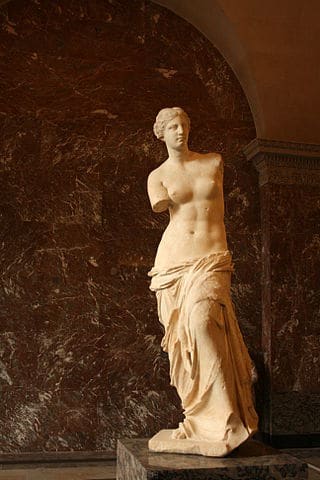The best way to see The Venus de Milo at the Louvre Museum
The Louvre Museum in Paris is not only one of the most visited monuments in the city, its one of the most visited museums in the world! And, for good reason! The Louvre is the home to world famous masterpieces such as the Mona Lisa, The Winged Victory of Samothrace and…the Venus de Milo!
The size of the Louvre can be overwhelming, and which can be a turn off for some. Well, those of you who haven’t dared enter the Louvre before, or for those of you who are itching to get inside, I’ve got a great article for you!
Don’t let the Louvre scare you! And, don’t get stuck wandering aimlessly around without seeing what you really want. I’m going to be giving you a step-by-step guide to the best way to see the Venus de Milo at the Louvre Museum!
Practical Information
Entry fee: 15-17 euros
Opening hours: Open every day except Tuesday 9am-6pm, Wednesday & Friday until 9:45pm
Address: Rue de Rivoli, 75001 Paris
Metro: Palais-Royal Musée du Louvre / Pyramides
Website
Step 1: Read up on the history of the Venus de Milo
Before you head to the Louvre museum to see the Venus de Milo in person, try to read up on the history of the statue! To help you avoid running around in circles with Google, I’m happy to fill you in here.
The Venus de Milo is a mysterious statue that was found off the coast of the island Melos (or, Milos in modern Greek, which is where “Milo” stems from) in Greece in 1820. Ever since it’s discovery, the statue has caused scientists, art historians and archeologists alike to scratch their heads.
The statue was originally discovered by a Greek peasant and a French naval officer. It was then presented to King Louis XVIII by the Marquis de Rivière. In 1821, the king donated the statue to the Louvre.
It’s assumed that the statue was made around 100 BC, due to characteristics found in other statues made in that time. It is made up of 2 blocks of marble, and scholars say that the bust, legs, left arm and foot were sculpted separately and then attached using vertical pegs. The goddess portrayed was originally wearing metal jewellery that consisted of a headband, bracelet and earrings. When the statue was found the jewellery was missing, and the only reason why we know it once was there are the presence of holes where the metal would have been fixed! You’ll also notice that the statue doesn’t have any arms, and that is because they were never discovered.
The most interesting part of the statue is that no one knows who she represents. Since a lot of the pieces were already missing when this mystery goddess was found, it’s really hard for historians and archeologists to know who she is!
Many people assume that she is the goddess Aphrodite because of her very feminine form. Another popular theory is that she is the goddess Amphitrite, a sea goddess that was venerated on the island of Melos. But, since her arms are missing, it is hard to say. She could also represent the goddess Artemis if she was holding a bow.
Some claim that the statue is a replica of another statue called the Aphrodite of Capua, which was made in the 4th century BC. More on why coming up!
Step 2: Buy your tickets in advance

If you get to the Louvre early and buy your tickets in advance, you’ll beat crowds like this one! Image by Victor Grigas – WikiCommons
If I had a euro for every time I give this piece of advice, I’d have at least 20 euros by now! All jokes aside, if you want to avoid waiting in endlessly long lines to get into the Louvre, or into any Parisian monument for that matter, buy your tickets in advance!
You’ll always have to wait in a line to go through security for safety reasons, but if you buy your tickets in advance you can head right to the museum entrance once you get inside. This is especially true in the Louvre, as word on the street is that they are planning on making pre-bought tickets a requirement!
Do yourselves a favor, and choose a time and date in advance to go to the Louvre to see the Venus de Milo. Trust me on this one!
Step 3: Admire the Louvre and the Tuileries Garden
Before you enter the Louvre museum, I definitely suggest that you take a few moments to admire the outside of the building, and the beautiful Tuileries Garden that surround it. The Louvre used to be a palace for the royal family until when King Louis decided the move the French court to the Château de Versailles.
There are definitely still palace vibes at the Louvre, especially on the outside. The architecture is stunning and ornate. There are countless statues and motifs carved into stone on the outside of the building. You’re going to want to spend some time taking it all in! Don’t miss the modern pyramid designed by the late I. M. Pei, too. Like most new things that arrive in Paris, the pyramid was not so loved in the beginning. But, after some time, tourists and Parisians alike have come to appreciate it!
When I first moved to Paris, my favorite picnicking spot in the city was the Tuileries Garden. Munching on a baguette and some cheese while sitting outside the Louvre?! I was hooked from the moment I walked into the gardens! There’s just something special about sitting in a place where so much history happened.
Why not book your tickets to enter the Louvre to see the Venus de Milo for the afternoon, and spend the morning in the Tuileries? Or vice versa! This makes for a great day of appreciating beautiful scenery, and equally beautiful art.
Step 4: Enter the Louvre and head to the Sully Wing
Once you step inside the Louvre museum and walk past all of the poor and unfortunate souls that chose not to buy their tickets in advance, you’re going to want to read directly to the Sully Wing. The Louvre is separated in to several different sections, or “wings.” Grab a map of the museum while you’re at it.
The Sully Wing is most well known for it’s many antiquities. It’s also the oldest part of the Louvre! When you enter the wing, you’ll notice that you can go downstairs to the Medieval Louvre section, where you’ll be ancient city walls that once protected Paris during the time of the Romans.
In the Sully Wing you’ll see pieces from ancient Egypt, Rome, Greece and the Middle East. Say hi to the massive Sphinx before you get to the Venus de Milo. Don’t worry about getting lost, there’s signs that will help you, your handy map and the people that work in the Louvre are helpful. Here is some more helpful information provided by the Louvre website:
“Enter the Bronzes room (room 663, level 1, Sully wing). Continue straight ahead and through room 662 (level 1, Sully wing). Once in the Salle des Sept-Cheminées (room 660, level 1, Sully wing), turn left. As you leave the room, you will find elevator C on your right. Take the elevator to the Greek Antiquities section on the ground floor. When you get out of the elevator, the Venus de Milo will be immediately to your left (room 345, level 0, Sully wing).”
You’ll find the Venus de Milo there waiting for you in room 345!
Step 5: Study the Venus de Milo and appreciate it’s beauty
Once you’ve made it to the Venus de Milo, try not to get discouraged by the crowds of people clamouring around the statue. Wait for your moment, and approach the mysterious goddess to get a closer look!
I mentioned in step 1 of this article that there are some historians and scholars that believe the Venus de Milo is a replica of a 4th century BC statue called the Aphrodite of Capua. This statue is a work of the Romans, which is a copy of a Greek original.
Scholars say that the Venus de Milo was possibly modelled after an original classic sculpture, but an original that dates back to 2nd century BC, not 4th century. And, some of the characteristics of her face, hair and body mirror styles from the 5th century. This is why it’s so hard to determine who the statue represents and who was the artist that made her.
One thing that is certain, is that the Venus de Milo was made using innovations that arose in the Hellenistic period between the 1st and 3rd centuries BC. The composition and body type represented are both very typical of this period. The Venus de Milo is unique due to it’s blending of styles from both the Hellenistic period and the ancient Greeks. She is something to admire surely!
Step 6: Explore the rest of the Louvre!
If you’re not too tired after seeing the Venus de Milo, I definitely recommend you check out some more of the Louvre. It is an absolutely massive museum that I’ve never finished in one day. Push yourself to see as much as you can, but don’t get discouraged if you don’t see everything.
Visit the rest of the Sully Wing to see some Egyptian art, and even more Greek works. You’ll also be able to see art from Ancient Iran, Arabia and Levant. Don’t miss their collection of French paintings, and some drawings, too!
There is also an impressive collection of Decorative Arts from the 17th and 18th centuries in the Sully Wing as well.
Conclusion
Are you ready to visit the Venus de Milo in the Louvre? I hope after reading this article, you are now! Follow my step-by-step guide and get the most out of your visit to the Louvre.
If you want to learn even more about what you can see in Paris, why not join one of our walking tours? Click here to learn more and to make your booking!
Planning a trip to Paris ? Get ready !
These are Amazon’s best-selling travel products that you may need for coming to Paris.
Bookstore
- The best travel book : Rick Steves – Paris 2023 – Learn more here
- Fodor’s Paris 2024 – Learn more here
Travel Gear
- Venture Pal Lightweight Backpack – Learn more here
- Samsonite Winfield 2 28″ Luggage – Learn more here
- Swig Savvy’s Stainless Steel Insulated Water Bottle – Learn more here
Check Amazon’s best-seller list for the most popular travel accessories. We sometimes read this list just to find out what new travel products people are buying.















